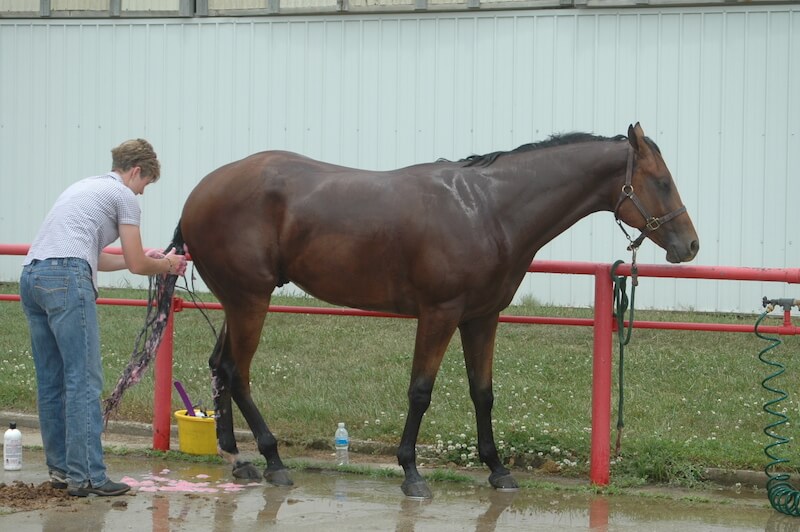Help Your Horse Cope with Hot Weather
by Laurie A. Cerny

The heat of summer can take its toll on horses. Rising temperatures and high humidity not only make it uncomfortable they also add stress, especially to equine seniors and horses with respiratory problems. There are several things horse owners can do to make their equine partners more comfortable at home and at a horse show, from offering shade and good ventilation to stabled/pastured horses to trailering show horses during the coolest times of the day.
Here are some tips for helping your horse deal with the heat:
- Provide shade. For pastured animals this means either a shade tree, a run-in shed, or access to a stall. At an outdoor horse show give your horse a break when waiting for classes by standing in a barn aisleway or under a tree.
- Increase ventilation for stabled horses. Fans and open doorways are a great way to allow air movement through a barn. Box fans offer a nice relief in individual stalls. Adding a half door or using a stall guard also allows airflow into a stall.
- Pay attention to the movement of the sun and to which parts of your barn get hot at certain times of the day. Stalls located near barn walls that get southern or western exposure can get 5-10 degrees hotter than stalls located elsewhere. If possible, rotate horses so the ones that are normally in those stalls during the heat of the day are moved to the cooler side of the barn.
- Consider adding windows to your barn (if you don’t already have them). Turning a stall into a run-in stall will also add a doorway and additional airflow to an otherwise long and closed in area.
- Consider planting trees, especially conifers, near your barn. These trees will offer shade in the summer and block harsh winds during the winter.
- Provide plenty of clean, cool water to horses at all times. An average adult horse should drink at least 5-10 gallons per day (20-25 daily during very hot weather). If your horse is not adequately drinking water add salt to their grain. You can also soak your horse’s hay to help increase water intake.
- Keep horse-wear to a minimum. Heavy blanketing would be just like wearing your winter coat in the summer. Stick with summer sheets (of light color) when blanketing for a show.
- Use a fly mask for outdoor turnout. Masks not only provide fly protection, but also block out sunshine, which is helpful for horses with photosensitivity.
- Exercise horses at the coolest times of the day.
- Haul early in the morning and in the evening when possible. During extremely hot weather hose your horse down before loading.
- Stalls at horse shows can become sweltering if there are no windows in the stables. Take a box fan and make sure to get your horse out of the stall several times daily.
- Feed small amounts of hay more frequently and cut back on heat producing forages like heavy grains. This will help keep body heat from spiking after a large feeding.
- Monitor your horse’s stress level, including vital signs, sweating, and the amount of water consumption. Normal respiration rate is 8-20 breaths per minute. Normal pulse is 28-45 beats per minute. And the normal temperature for a horse is 99-101 degrees Fahrenheit.
- Don’t overwork horses during extremely hot and humid weather. Horses can suffer from heat stroke, just like humans. During long training sessions, periodically give horses a 5-10 minute break. At an all-day horse show you may need to consider dropping a class or two. Horses with heavy exercise and show schedules should also be supplemented with electrolytes.
Published July 2013 Issue

The Colorado Horse Source is an independently owned and operated print and online magazine for horse owners and enthusiasts of all breeds and disciplines in Colorado and surrounding area. Our contemporary editorial columns are predominantly written by experts in the region, covering the care, training, keeping and enjoyment of horses, with an eye to the specific concerns in our region.

